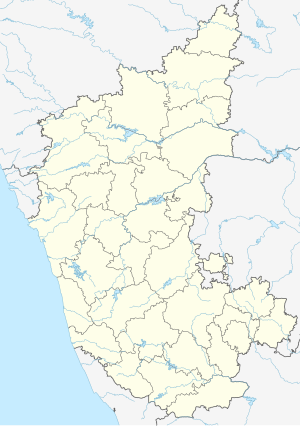Bijapur Fort
| Bijapur Fort | |
|---|---|
| Part of Bijapur | |
| Bijapur, India | |

View of Bijapur Fort from the moat
|
|

Layout Plan of Bijapur Fort
|
|
| Coordinates | 16°49′39″N 75°42′31″E / 16.8276°N 75.7087°E |
| Type | Fort |
| Site information | |
| Controlled by | Government of Karnataka |
| Open to the public |
Yes |
| Condition | Ruins |
| Site history | |
| Built | 16th century |
| Built by | Yusuf Adil Shah in 1566 |
| Materials | Granites and lime mortar |
The Bijapur Fort (Kannada: ವಿಜಾಪುರ ಕೋಟೆ Vijapur kote) is located in the Bijapur city in Bijapur District of the Indian state of Karnataka. Bijapur fort has a plethora of historical monuments of architectural importance built during the rule of Adil Shahi dynasty.
The Adil Shahi Sultans who ruled for nearly 200 years in Bijapur had expended their utmost authority, almost exclusively, on architecture and the allied arts, each Sultan endeavored to excel his predecessor in the number, size, or splendor of his building projects. As a result, the buildings seen in and around Bijapur Fort and the town have been rightly called as the Agra of South India.
The rich history of the fort, the citadel and other structures is subsumed in the history of Bijapur city, which was established in the 10th–11th centuries by the Kalyani Chalukyas. It was then known as Vijayapura (city of victory). The city came under the influence of the Khilji Sultanate in Delhi by the late 13th century. In 1347, the area was conquered by the Bahmani Sultanate of Gulbarga. By this time, the city was being referred as Vijapur or Bijapur.
Yusuf Adil Shah, son of Murad II, the Sultan of Turkey had joined the Bidar court of the sultanate in 1481 under the then Sultan Mohammed III. He had been purchased as slave by Mahmud Gavan, the Prime Minister of the Kingdom. He was later, in 1481, appointed as the Governor of Bijapur for his loyalty and bravery shown in the active defense of the sultanate. The fort and the citadel or Arkilla and the Faroukh Mahal were built by him with the skilled architects and artisans whom he had inducted into his employment from Persia, Turkey and Rome. Yusuf declared himself independent of Sultan’s rule and thus established the Adil Shahi dynasty or the Bahmani kingdom, in 1489 (in 1482, the Bahmini empire broke into five kingdoms and Bijapur sultanate was one of them).
...
Wikipedia

